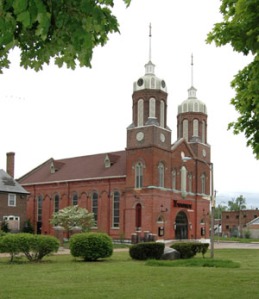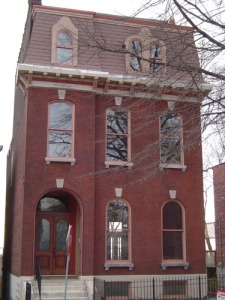March 2009
Monthly Archive
March 20, 2009
Posted by PNJ Executive Director under
Uncategorized
Leave a Comment
News just in that the New York State Assembly and Senate have introduced new legislation to expand the existing NYS Rehabilitation Tax Credit programs for historic commercial properties.
A partnership of economic development, banking, municipal leaders and other organizations have formed the Reinvest NY Partnership to secure this rehabilitation stimulus program in the 2009-2010 NYS final budget agreement.
Existing Commercial Program
6% credit rate, $100,000 cap, no transferability (credit only allocated to entity claiming federal credit).
Proposed new Commercial Program
20% credit rate, $5 million cap; transferability within business partnerships, available in census tracts at or below 100% State Median Family Income, implementation date of 1/1/2010.
For further details, contact Daniel Mackay, Director of Public Policy, Preservation League of NYS @ dmackay@ preservenys.org
Join New Jersey’s Coalition seeking to enact a state rehabilitation tax credit: info@njheritagedevelopment.org
March 14, 2009
Posted by PNJ Executive Director under
Uncategorized
Leave a Comment
The National Park Service’s 2008 annual report on the use and impact of the federal historic rehabilitation tax credit on real estate investment shows, once again, a direct correlation between existence of a companion state historic tax credit and the level of investment in historic rehab projects.
The national highlights :
- $5.64 billion in leveraged investment in historic rehabilitation projects linked to federal tax credits
- 17,051 housing units created, 5,220 of them low/moderate income
- 67,700 (estimated) jobs created
Now for the New Jersey perspective:
- New Jersey was #27 in the number of “new” (Part 2) projects approved, sharing the spot with Montana & New Mexico. NJ’s two approved projects compares to Missouri’s 153, Virginia’s 119, Ohio’s 85, Maryland’s 39 and Rhode Island’s 31. (The latter 5 states all have companion state credits, NJ does not.)
- NJ is #25 in finished federal tax credit-driven projects: three (3) completed projects. Missouri = 134, Virginia = 73, Maryland = 61
- NJ moved up to 9th place in the value of completed projects in 2008, at $137 million. Missouri = $376 m, Massachusetts = $324 (that state, too, has a state tax credit), Virginia = $242 m
Perhaps the reader sees a pattern?
Read the report” nps-2008taxcredit_report2
March 2, 2009
Posted by PNJ Executive Director under
Uncategorized
Leave a Comment
from PreservatioNation:
About Missouri’s Rehabilitation Tax Credit
In total, 29 states offer some form of tax credit for rehabilitating older buildings, and for good reason – these incentives are absolutely critical to preserving local heritage. However, not all state credits are created equally and, as a result, overall effectiveness varies considerably.
As one of the first states to enact such a program, Missouri continues to lead the way with its rehabilitation policy, which currently offers a 25% credit for qualified expenses in rehabilitating commercial and owner-occupied properties listed on the National Register or located in a certified historic district.

Former church, now the Ivory Theatre, rehabbed with state tax credits
Unlike the federal-level rehabilitation tax credit, the Missouri state-level credit includes residential properties – although they comprise only about 3% of all historic tax credit projects in Missouri – into the mix. For commercial projects, the state-level credit can be “stacked” or combined with other federal incentives.
Another important component of Missouri’s exemplary credit is that it permits transferability, or the ability to make an outright transfer of the tax credit to another person or entity. This provision allows the party that earns a credit – which may not have substantial tax liability – to sell the credit to a third party with greater tax liability.
Above all, the most crucial aspect of Missouri’s highly successful historic tax credit is the absence of either an annual aggregate or a per-project cap. These types of restrictions typically lead to a high degree of uncertainty for developers, lenders and investors, therefore resulting in a sharp decline in usage.
Missouri’s Rehabilitation Tax Credit By the Numbers

St. Louis residence rehabbed with state tax credits help
In just ten years, over 900 rehabilitation projects in 37 counties and 55 communities across the state of Missouri have been completed thanks to the historic tax credit. This translates into over $2 billion that has been invested in the rehabilitation of historic buildings.
The program works for small as well as large projects. Only 11% of the projects completed were those with over $5 million in expenditures. The majority are smaller preservation projects. In fact, over 45% had less than $250,000 in expenditures, and nearly 15% were below the $100,000 mark.
Not surprisingly, Missouri leads the nation in use of the federal-level rehabilitation tax credit. Statistics from Missouri show that having a productive state historic preservation tax credit program increases the use of the federal tax credit. According to state officials, the number of projects using federal rehabilitation tax credits doubled after the introduction of the state credit.
Visible Impact of Missouri’s Rehabilitation Tax Credit
From the rehabilitation of Main Streets and residences to the transformation of major urban centers, the impact of Missouri’s policy can be seen across the state. One of the biggest success stories comes from St. Louis, (more…)

